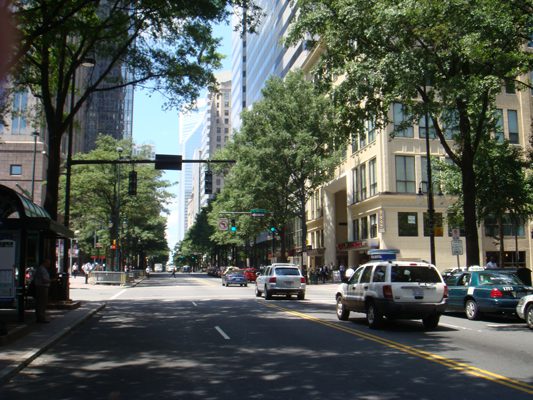Should Charlotte Look Like Paris or Atlanta?

What should Charlotte look like? When discussing urban design many planners, architects and developers assume that what works in New York, San Francisco and Portland should work here. This assumption ignores the reality that Southerners have a very different perspective on “urbanness” than non-Southerners. No one has asked Charlotteans what they want their city to become, until this past summer.
Urban geographers at UNC Charlotte conducted a mail survey in the summer of 20101 which asked Charlotte residents about the important factors in selecting their neighborhood and where they wanted municipal investment to occur. In aggregate the questions were intended to identify what features of urban design were most important to individual homeowners. Since urban growth in the South is increasingly characterized by tensions between recent arrivals (often from Northeastern cities) and long-term Southerners, survey results were analyzed from the perspective of Southern versus non-Southern (and suburban versus in-town) residents. Results of the survey are shown in Tables 1 and 2 below.

Table 1 shows response means for the neighborhood selection series of questions. Opinions were measured using a Likert scale (respondent’s opinions about each residential choice recorded on a five point scale which ranged from “critically important” to “completely unimportant”). In-town residents considered proximity factors (access to businesses, work and green space) to be among the most important elements of neighborhood choice. School quality, access to entertainment and transit were among the least important factors. As expected, suburbanites placed less emphasis on proximity to work while placing greater importance on school quality.
Also significant were the differences in opinion between Southern and non-Southern respondents. Non-Southern in-town residents expressed a stronger preference for high-density urban environments than Southerners. These preferences included the availability of neighborhood businesses, proximity to urban amenities and access to public transit. Differences between Southern and non-Southern residential preferences in the suburbs were considerably less pronounced with the exception of walkability.

Table 2 summarizes personal attitudes towards public expenditures on urban development. In-town residents consider expansions of downtown activity and expansion of public transport to be of primary importance in Charlotte’s growth. As expected, this group viewed investment in the suburbs to be less critical to Charlotte’s future. Non-Southern in-town residents expressed an even stronger preference for the expansion of public transit. While suburban residents placed greater emphasis on suburban projects than in-town residents, suburban support for investment downtown remained strong (4.27 out of 5 for non-Southern suburbanites). A variety of residential options and even the expansion of public transit was considered to be of above average importance by the suburbanites.
Several noteworthy findings can be isolated from this preliminary case study. First, Charlotte’s suburbanites (particularly the non-Southern ones) appear to feel strongly that they benefit from a vital downtown and the expansion of public transit. Charlotte’s suburban residents appear to value their connections to downtown. Second, suburbanites did not express distaste for making the suburbs more urban (as evidenced by responses to the suburban housing and suburban job growth questions). That attitude is consistent with the emergence of mixed land uses in the neo-traditional town centers of Charlotte’s suburbs (e.g. Ballantyne and Birkdale). Finally, while Southerners expressed less preference for dense urbanization, the differences separating the Southern and non-Southern opinion in this category were relatively small. Southerners and non-Southerners were remarkably consistent in prioritizing proximity to work, price/size of housing, school quality and property tax rate in residential selection.
While much of these data are consistent with expectations it is encouraging to find suburban and in-town residents share a sense that downtown and suburban areas are interconnected in Charlotte. These survey results indicate most residents feel that downtown Charlotte is worthy of investment. It also appears that suburban residents consider suburban growth (and the increased densities that growth implies) to be of value as well (despite persistent questions about road and school capacity). There is some evidence that Southerners are somewhat less enthusiastic about increased urban density than the new arrivals to the region. Despite some small differences in opinion between groups the overall opinion of respondents appears to be that Charlotteans prefer a higher-density, more urban future for their city.
Photograph by John Chesser
1Data were gathered via a June 2010 postal survey sent to residents of single family homes in 28203 (the Dilworth area) and 28277 (the Ballantyne area). The target zip codes and selection of only single family house addresses likely skewed the sample towards affluent households. Five hundred surveys were mailed to residents of each zip code with post-paid return envelopes; respondents could alternatively reply via a web interface. A total of 155 responses were received making the overall response rate 15.5% (86 responses were received from 28203, 69 from 28277). The survey was a pilot study which is part of a larger ongoing project on Southern urbanization.